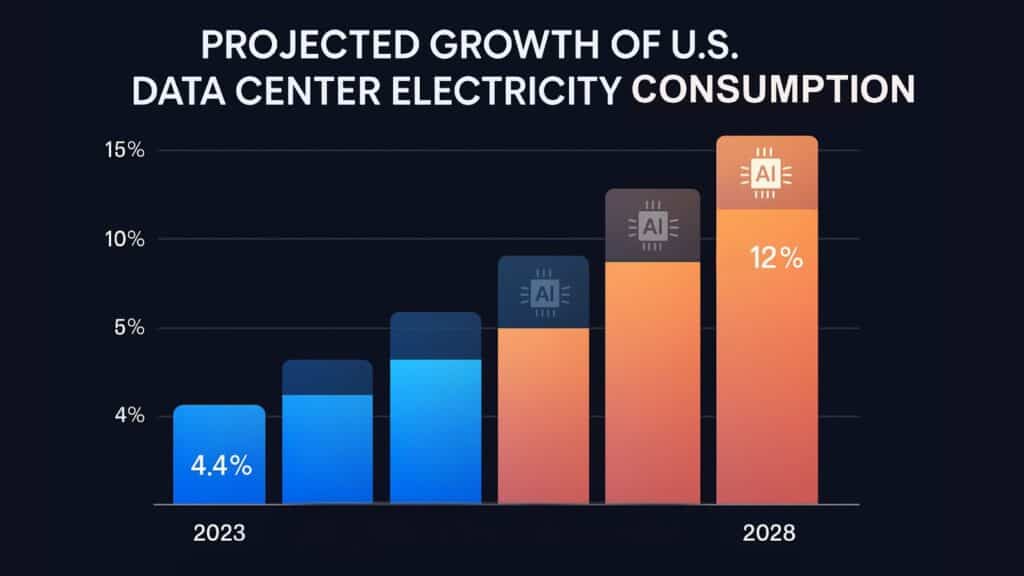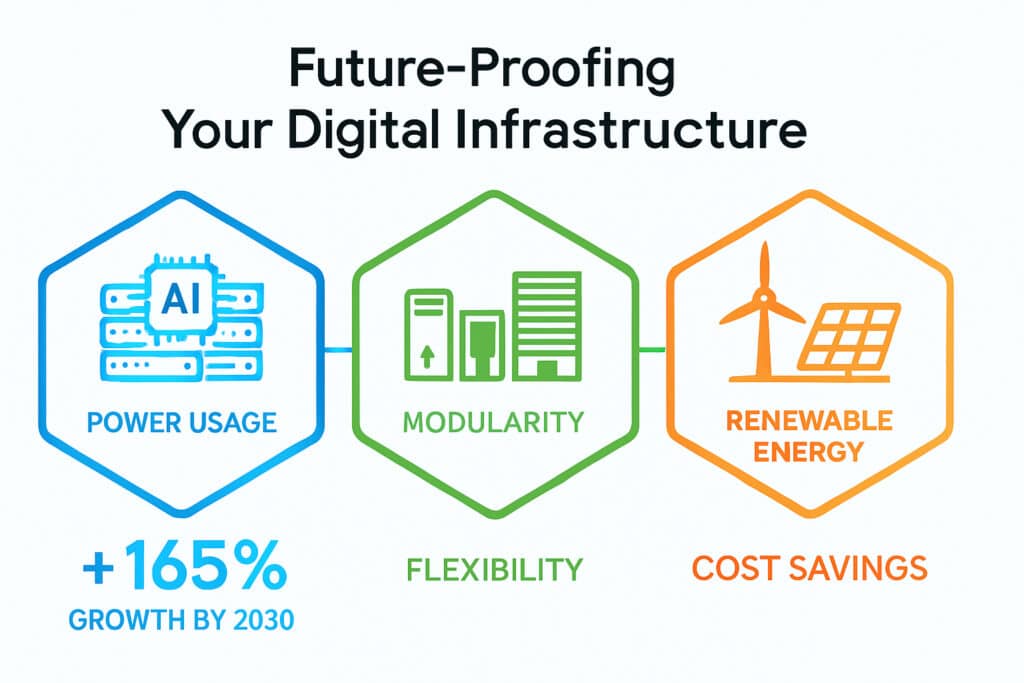The race to implement advanced technologies has businesses across industries investing heavily in digital infrastructure solutions to support their operational needs. From artificial intelligence to cloud computing, the backbone of modern business operations depends on robust infrastructure capable of handling massive computational workloads.
This shift isn’t temporary. It represents a fundamental transformation in how organizations process, store, and utilize data. As digital growth accelerates, companies face unprecedented challenges in securing reliable power sources and scalable facilities to support their expanding technological footprint. The businesses that strategically address these infrastructure demands now are positioning themselves for sustainable competitive advantages in an increasingly digital marketplace.
The Rising Demand for Digital Infrastructure Solutions
Digital transformation initiatives are driving extraordinary demand for specialized infrastructure. According to research from Berkeley Lab, U.S. data centers consumed approximately 176 terawatt-hours (TWh) of electricity in 2023, representing about 4.4% of total U.S. electricity consumption—a figure that could reach up to 12% by 2028 due to accelerating AI adoption and digital growth. This dramatic increase reflects how digital infrastructure has become essential for business operations across sectors.

The current infrastructure expansion goes beyond traditional IT needs. Modern digital infrastructure solutions encompass a range of components designed to support advanced computing applications. Two critical developments are driving this evolution in particular—the exponential growth of AI workloads and the continued expansion of cloud computing infrastructure.
Power-Intensive AI Applications Driving Infrastructure Evolution
AI computing can demand four times the power of traditional workloads, with GPU-intensive applications drawing significantly more electricity than conventional CPU-based operations. The average rack power density in colocation facilities has doubled from approximately 6 kW to 12 kW in recent years, yet even these enhanced capacities prove insufficient for cutting-edge AI hardware deployments. This exponential growth in power density requirements is forcing organizations to rethink their digital infrastructure approach.
Enterprise adoption of AI has moved from experimental to mission-critical, creating urgent demand for infrastructure capable of supporting intensive computational workloads. Organizations implementing large language models or computer vision systems require not just more power, but more reliable and consistent power delivery to maintain performance and avoid costly disruptions.
Cloud Expansion Requiring Scalable Solutions
Cloud computing continues to expand as a foundation for business operations, demanding larger and more distributed infrastructure networks. Industry analysis from JLL indicates the colocation market doubled in just four years, with vacancy rates reaching a record low of 3%—clear evidence of the surging demand for digital infrastructure. This scarcity is compelling businesses to secure dedicated infrastructure resources before they become unavailable.
The cloud’s elasticity depends entirely on having sufficient physical infrastructure to support workload fluctuations. As enterprises migrate more workloads to cloud environments, the underlying digital infrastructure must evolve to handle variable demands while maintaining consistent performance. This balancing act requires sophisticated infrastructure planning that anticipates future capacity requirements.
Challenges in Securing Adequate Digital Infrastructure
The unprecedented growth in computing needs has created some critical challenges for organizations seeking reliable digital infrastructure solutions:
- Power Availability Constraints
Power availability has emerged as the primary bottleneck for digital infrastructure development. JLL’s market analysis found data center power loads growing at approximately 21% compound annual growth rate (CAGR) in recent years, significantly outpacing new power generation capacity. This imbalance has created competitive markets for available power resources, particularly in established technology hubs.
Utility connection timelines have extended dramatically, with some regions reporting up to 5 years to provide new capacity for data centers, significantly delaying projects and forcing businesses to make difficult decisions about infrastructure placement and expansion timelines.
- Grid Reliability Concerns
The reliability of existing power grids raises additional concerns for organizations deploying mission-critical applications. Traditional backup systems like diesel generators produce significant emissions—reportedly 200-600 times more nitrogen oxides than natural gas plants per unit of energy—making them increasingly problematic from both regulatory and corporate sustainability perspectives.
As enterprises become more dependent on digital operations, even momentary power disruptions can cause significant financial and operational impacts. This vulnerability is driving investments in alternative power arrangements like microgrids and on-site generation to ensure business continuity regardless of grid conditions.
- Sustainable Infrastructure Requirements
Corporate sustainability commitments add another layer of complexity to digital infrastructure planning. Major technology companies have established ambitious carbon reduction goals, requiring their infrastructure providers to deliver both reliability and environmental performance.
The environmental impact of traditional data centers has become increasingly measurable, with researchers estimating U.S. data center air pollution cost approximately $6 billion in public health damages in 2023, potentially rising to $10-20 billion by 2030 without intervention. These externalized costs are beginning to influence infrastructure decisions as regulatory scrutiny increases.
The Business Impact of Strategic Infrastructure Investments
Organizations making thoughtful digital infrastructure investments can realize significant advantages:
Accelerated Time-to-Market
Companies with secured infrastructure resources can deploy new digital initiatives faster than competitors constrained by infrastructure limitations. This velocity advantage becomes particularly valuable in fast-moving markets where being first with new capabilities can establish market leadership.
The contrast between proactive and reactive infrastructure approaches can be stark: proactive organizations typically reduce deployment timelines by 40-60%, allowing them to capitalize on market opportunities that might be missed by less prepared competitors.
Enhanced Operational Resilience
Properly designed digital infrastructure solutions incorporate multiple layers of redundancy and protection against various potential disruptions. This resilience translates directly to improved business continuity and reduced operational risk.
The financial impact of infrastructure resilience becomes evident during disruptive events, from weather emergencies to grid instability issues. Organizations with robust infrastructure face significantly fewer operational disruptions during such events, preserving both revenue and customer confidence. According to Uptime Institute’s 2024 Annual Outage Analysis, more than half (54%) of organizations report that their most recent significant outage cost more than $100,000, with 16% reporting costs exceeding $1 million. These findings underscore why investments in resilient digital infrastructure solutions are critical economic decisions, not merely technical considerations.
Competitive Differentiation Through Digital Growth
Digital capabilities increasingly define competitive positioning across industries. Organizations with access to scalable, reliable infrastructure can introduce new digital products and services that less-prepared competitors cannot match.
This infrastructure-enabled innovation creates virtuous cycles of digital growth, where each successful digital initiative builds market share and generates resources for further advancement. The long-term competitive implications are substantial, as infrastructure advantages compound over time.
5 Essential Strategies for Future-Proofing Your Digital Infrastructure
As technology continues to evolve, organizations must consider how today’s infrastructure decisions will impact tomorrow’s capabilities. These five strategic approaches help businesses build technological foundations that support long-term growth without requiring complete rebuilds as needs change.
1. Plan for AI-Driven Demand Growth
Artificial intelligence represents both the greatest opportunity and the greatest infrastructure challenge for many organizations. According to Goldman Sachs Research, global data center power demand is projected to grow by 165% by 2030 compared to 2023 levels—nearly tripling current requirements primarily due to AI workloads. Infrastructure strategies must account for this extraordinary growth trajectory.

Organizations should evaluate their AI roadmaps alongside their infrastructure plans, ensuring alignment between computational ambitions and physical resources. This coordination requires cross-functional collaboration between technology leadership, facilities management, and sustainability teams. Without this proactive approach, companies risk finding themselves constrained by infrastructure limitations just as AI capabilities become most valuable to their competitive positioning.
2. Implement Flexible, Modular Approaches
The pace of technological change makes infrastructure flexibility increasingly valuable. Modular designs allow organizations to scale incrementally while incorporating new technologies as they emerge, rather than committing to fixed approaches that may become obsolete. This adaptability proves essential as computing requirements continue evolving at unprecedented rates.
This flexibility extends to power and cooling systems, where modular components can be upgraded or reconfigured without disrupting existing operations. Such adaptability preserves capital while ensuring infrastructure remains aligned with evolving business requirements. Organizations that invest in modular infrastructure can respond to new opportunities without the delays and costs associated with major infrastructure overhauls.
3. Embrace Energy-as-a-Service Models
Traditional infrastructure ownership models are giving way to more flexible arrangements where specialized providers deliver complete infrastructure solutions under service agreements. These models allow organizations to access state-of-the-art facilities without the capital expenditure and operational complexity of direct ownership.
Energy-as-a-service approaches are particularly valuable for managing power-related challenges, as they transfer responsibility for securing adequate, reliable, and sustainable energy to specialists with deep expertise in navigating complex energy markets and regulations. This approach enables organizations to focus on their core business while ensuring their infrastructure needs are met by experts who understand the rapidly changing energy landscape.
4. Prioritize Power-First Development Strategies
The most successful infrastructure projects now begin with power availability rather than location convenience. This power-first approach recognizes that securing adequate energy resources determines project viability more than any other single factor. By identifying and securing power commitments early in the development process, projects can move forward with confidence that critical resources will be available when needed.
This methodology involves comprehensive utility engagement, grid impact analysis, and often requires developing creative solutions for power delivery to sites that traditional approaches cannot serve. The result is infrastructure that can actually support the computational workloads businesses need rather than facilities constrained by power limitations. Organizations that adopt power-first thinking avoid the costly delays and compromises that plague projects where power becomes an afterthought.
5. Integrate Renewable Energy Solutions
Modern digital infrastructure development increasingly treats renewable energy as a foundational component rather than an add-on consideration. This integration approach combines on-site renewable generation with energy storage systems to create facilities that can operate independently of grid constraints while providing environmental benefits.
The most advanced implementations create energy campuses that generate more clean power than their computing operations consume, transforming digital infrastructure from an energy burden into a grid asset. These facilities can supply excess renewable energy back to the grid during peak demand periods, creating additional revenue streams while supporting broader grid stability. Enterprise adoption of these integrated approaches accelerates as organizations recognize both the operational and financial advantages of energy independence. By controlling their power source, companies gain predictable energy costs, enhanced reliability, and the ability to meet ambitious sustainability commitments.
Taking Action on Digital Infrastructure
The convergence of AI adoption, cloud expansion, and digital transformation has fundamentally changed infrastructure requirements for forward-thinking organizations. Companies that recognize digital infrastructure solutions as strategic assets rather than operational expenses gain significant advantages in operational efficiency, market responsiveness, and sustainable growth.
As computational demands continue their exponential increase, proactive infrastructure planning becomes increasingly critical. Organizations must evaluate their current digital footprint and anticipated growth to ensure their infrastructure strategy aligns with both short-term needs and long-term ambitions.
174 Power Global addresses these challenges by developing integrated energy solutions specifically designed for power-intensive digital infrastructure. Our approach combines renewable generation with energy storage to provide reliable, sustainable power for next-generation computing facilities through comprehensive land development, power sourcing, and energy campus creation.Ready to explore how your organization can secure the digital infrastructure needed for sustainable growth? Contact the experts at 174 Power Global to discuss customized solutions that meet your specific requirements.



